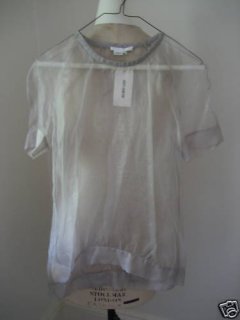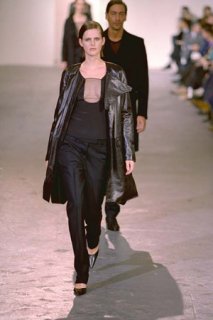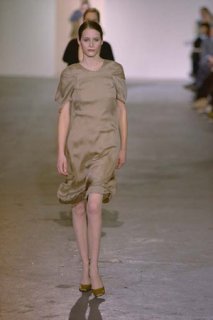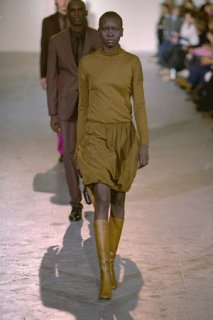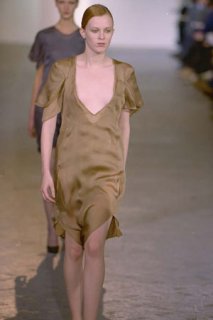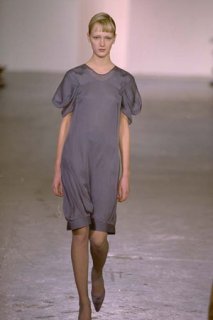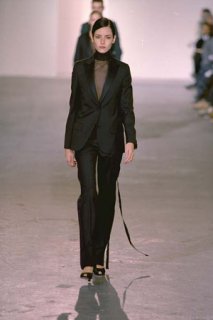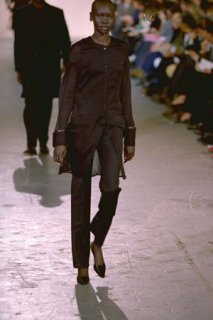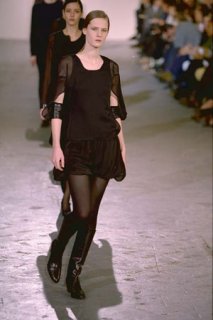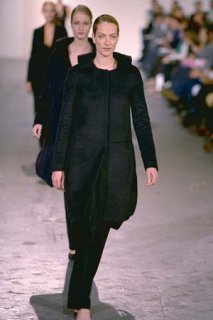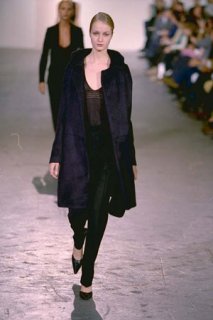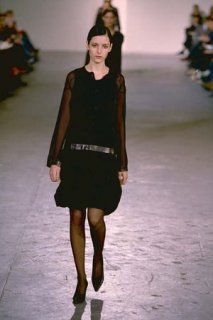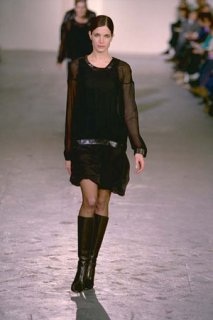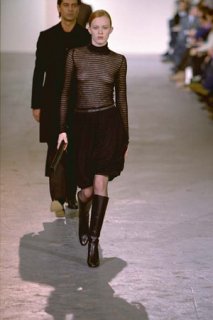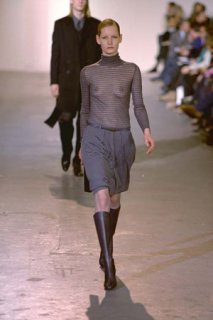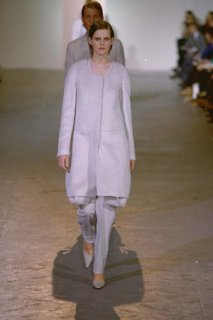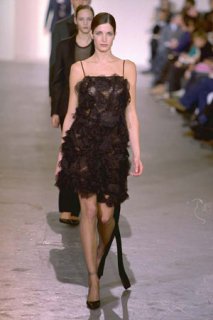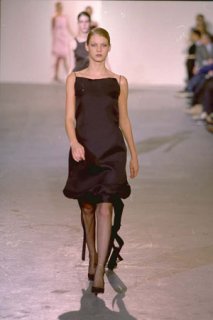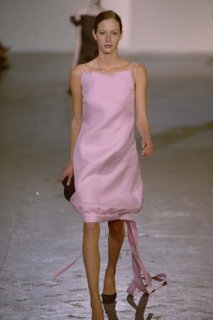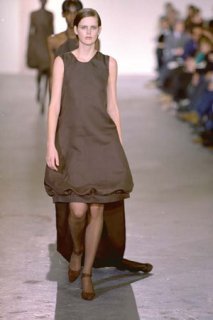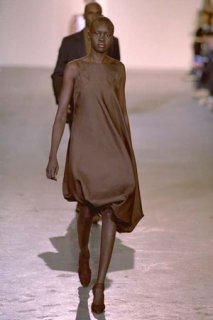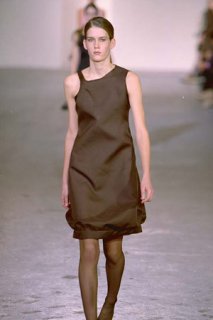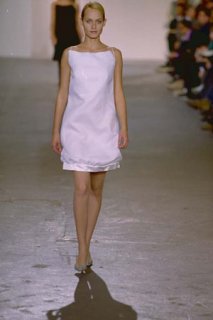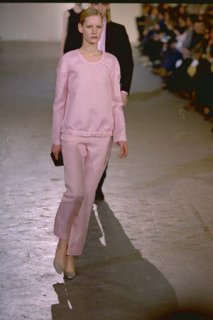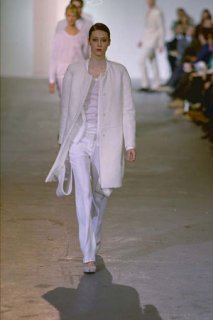You are using an out of date browser. It may not display this or other websites correctly.
You should upgrade or use an alternative browser.
You should upgrade or use an alternative browser.
Helmut Lang, 1988 to 1997
- Thread starter runner
- Start date
JuiceMajor
Active Member
- Joined
- Jul 8, 2005
- Messages
- 4,509
- Reaction score
- 1
He is on this Wallpaper October 2008. There is a article of him in conversation with Louis Bourgeois.


wallpaper.com


wallpaper.com
MissMagAddict
Well-Known Member
- Joined
- Feb 2, 2005
- Messages
- 26,621
- Reaction score
- 1,353
Source | W Magazine | October 2008
Helmut Lang
Three years ago he shocked the fashion world by walking away from the groundbreaking label he founded. Now the designer-turned-artist unveils his new work.
By Diane Solway
Photographed by Bruce Weber
It’s one of those glorious, cloudless days of summer, and Helmut Lang, the avatar of stripped-down, urban cool, strides past the restored 1790 farmhouse, the shingled chicken coop, the organic vegetable garden and the assorted ducks scrambling on his East Hampton oceanfront property to greet me. One of the most influential designers of the Nineties, whose cult status endures, Lang has been pretty much ensconced in this bucolic idyll since selling his remaining shares in his company to the Prada Group in 2004 and soon after resigning from the house he created. For the past three years, fashionistas have mourned his departure while speculating about what he’s been up to. But the über private Lang has remained mum about his new projects. All that is about to change: The 22 artworks that recently sat in various states of assembly on Lang’s front lawn, in his barn and inside his wood-beam house are now on view at the Kestnergesellschaft, a contemporary exhibition space in Hanover, Germany, which has just unveiled the first major solo exhibition by the artist formerly known as fashion designer Helmut Lang.
To Lang’s devotees, those who lived by his style dicta and spoke of his low-rise jeans in reverent tones, his shift from the center of the fashion universe to a solitary studio might seem a radical leap. But Lang’s sensibilities have always been firmly rooted in the realm of art. “I always felt that Helmut wasn’t really in the fashion world—he was in his own world,” says photographer Bruce Weber, a longtime friend who regards Lang as something of an outsider artist. In fact, it was Lang’s collaborations with Jenny Holzer and Louise Bourgeois in the Nineties and his appropriation of Robert Mapplethorpe photographs for print ads that helped usher in the current mash-up of art and fashion.
As Lang sees it, his latest incarnation is simply “an evolution, a progression,” not a break. “I wanted to explore everything I knew on a different level,” says the Austrian-born Lang, now seated under a trellis at a simple wooden table overlooking sand dunes and the ocean beyond. “The size of the company kept growing, and I had the feeling at one point that I would become the victim of my own success and get pushed further away from what I worked so hard to be able to do. I did try to do more artistic work in between, but it was not possible to be one of the main players in the fashion world and then to do art at the same time. I was ready to take a new challenge, in part because in fashion, things have become very predictable.” His approach—whether to making fashion or art—is the same: “to arrive somewhere completely different from where you started.” Risk comes with the territory. “Once I’m committed,” he says, “I’m unafraid of the outcome.”
Lang redefined the face of modern fashion largely by listening to no one but himself. When asked if he fears taking his work public, he replies with Yoda-like equanimity: “It will mean something or nothing—but that is also part of the purpose. It’s time to grow, and eventually, it is what it is.”
At 52, Lang is tan and buff in his trademark uniform of black T-shirt and jeans. Only today, “funnily enough,” he notes, an amused smile lighting up his sober demeanor, “they’re by Levi’s, not Lang.” His dark brown hair, graying at the temples, is swept back and covered by a black cap that spells out swat in faded letters. Gentle and cerebral, he’s reluctant to probe or reveal, and his answers are often elliptical. Isaac Mizrahi he’s not. “I’m really bad at describing my own life,” he apologizes sweetly in accented English when asked whether he tends the organic garden out front. Taking the measure of the man can prove elusive, even for Lang’s closest friends. “Shy, reticent and mysterious,” is how sculptor Louise Bourgeois describes him. Artist Roni Horn goes further: “Helmut isn’t somebody you can approach head-on,” she says. “‘Enigma’ is a great word for him. He follows his own rhythms. He feels the undertow of his sensitivities, and that’s really more what’s directed him.”
To do something “slightly different,” points out Lang, “doesn’t mean that your personality goes away.” Horn says she wasn’t surprised by Lang’s latest move. “His clothing design was always sculptural in nature—very material based, very physical, and then sensual and sexual,” she says. “It’s his way of living and relating to things.” Asked for her appraisal, Bourgeois says in an e-mail, “Helmut is always experimenting. The subject is never the materials, but what you want to express.”
Just what Lang wanted to express as an artist took him some time to discover. He’s never been one to rush things. Preferring to experiment away from the public glare—just as he did when he started out as a designer in Vienna in the late Seventies—he moved to his house in East Hampton and told friends he was doing nothing. For a while he did. “The second you say something, everyone says, ‘When is it going to be shown?’ It’s this constant thing of ‘What’s next?’” he says, noting that he imposed this self-isolation to allow himself to think differently. “I wanted to take all the time I needed to feel comfortable with what I’m doing now, to transfer my voice to a different medium, to different proportions.” No longer ruled by the fashion calendar, he began archiving the clothes he’d designed and the notes and objects he’d collected.
In looking back, he found his way forward. One of his first art projects was his “Selective Memory Series” for the avant-garde magazine Purple—80 pages consisting largely of digitally manipulated notes from Lang’s friends and fashion colleagues. (“Never mind the awards, I looked smashing, didn’t I?” scribbled Roman Polanski in one of them.) Its publication caused a stir, not least because the authors had assumed that their private notes were just that. But the scrim between public and private has always intrigued Lang, who recalls that once he scanned the notes, they assumed an “accidental visual pattern” irrespective of time, rank or gender. In any case, he says, many of those featured were “probably glad to have been remembered and not shredded.”
Ironically, his debut exhibition (he presented a single work at Brooklyn’s Journal Gallery in 2007) came about when the Kestnergesellschaft proposed a retrospective of Lang’s career as a designer. Though Lang had started a fashion archive, even buying back a number of older pieces on eBay, he couldn’t muster enough enthusiasm to complete it. “I’m not interested. I’m doing new work,” he told the director. So the director offered to show that instead.
What’s striking about his new work is how deeply personal it is in the way that Lang recycles artifacts and details from his life, “materials that have the imprint of history on them,” says the show’s cocurator, Neville Wakefield. “There’s an extent to which he’s excavating his own past and stripping it of the associations it might have had and turning it into something new.” The same attention to detail, shape and materials is there, only now, says Lang, he can say what he wants in different proportions, forms and contexts, freed from the limitations of the human body and the way it moves. “And the waste in art is much less than in fashion,” he jokes.
The week before his sculptures and installations were shipped to Hanover, Lang gave me a tour. Inside the open barn, three wooden American eagles that once sat in his SoHo store had been sliced, transformed and weathered into abstracted forms. Arbor, a 40-foot maypole sculpture that Lang had constructed on the front lawn, referenced the community rituals of his rural Austrian childhood, though hanging from it were iron wreaths, with feathery strips recycled from a dismantled boa, in place of ribbons. Nearby were Lang’s lifeforms works—two nine-by-three-foot minimalist oak boxes filled with sheepskin and covered with tar—which, “depending on your emotional state,” says Lang, evoke either graves or gardens. On the floor inside the house, he carefully laid out several pieces from an astonishingly tactile, painterly series he calls surrogate skins. At first glance, they look like luxurious animal hides but, on closer inspection, reveal themselves to be accumulated layers of translucent paper that Lang spent considerable time coloring and gluing. “Most people start with a tabula rasa,” says Wakefield. “Helmut starts with something elaborate and often ornate and reduces it to its abstract essence, which is what he did in fashion as well.” In fact, the new works—much like Lang’s tailored peacoats, layered T-shirts and narrow, sharply cut suits made of unlikely fabrics—look remarkably casual, even nonchalant. But stay with them a while and you realize, says Wakefield, “that there is an incredible sort of alchemy of arrangement going on.”
That sense of arrangement is on view everywhere in his East Hampton home, where the woodpiles suggest that Donald Judd might have assembled them. “He’ll cook an Austrian dish, and the fish will be cooked so beautifully and then laid down on a beautiful piece of old linen,” says Weber of dinner chez Lang, “but not in a really thought-out way, just naturally, the way he likes to see things.”
Though solitude feeds him creatively, Lang shares the house and his New York apartment with his life partner, Edward Pavlick, a former fashion designer. They live simply, considering that Lang reportedly outbid Jerry Seinfeld for the $15.5 million spread. Lang restored the house to its origins, removing the cheap shingles on its exterior, for example, while leaving in place certain eccentric remnants of past alterations. “He had a memory of his grandfather’s house being a kind of mini farm,” recalls the architect Richard Gluckman, who worked on the house and designed Lang’s stores. “He wanted to recapture it.”
Lang was born in 1956 in Vienna but spent his childhood with his maternal grandparents in a remote town in the Austrian Alps, sent there after his parents divorced when he was five months old. His grandfather was a shoemaker, and Lang helped him in his workshop, mending and stitching leather mountain boots. They lived in an alpine house without a TV or a telephone, and it was there where Lang developed a keen sense of the natural order of things that continues to infuse his aesthetic. “To grow up under really simple circumstances,” he says, “and to understand that certain things were ornamental—the idea of the simple life interrupted by the opulence of particular festivities—that made an impression on me as a child and is something I use.”
The emotional tenor of Lang’s life changed abruptly at age 10, when he was sent to Vienna to live with his father, a truck driver, and an unloving stepmother who made him wear ill-fitting suits that had belonged to her father. (Lang’s mother had died some years earlier.) It was the late Sixties, and Lang, with his country ways and formal dress, was utterly out of step with his peers. “It was kind of counterproductive to my teenage market value,” he says dryly. “That kind of restrainment sharpened my sense of independence to a heightened degree.”
He left home at 18 and, casting about for a direction, pretty much fell into fashion in Vienna, he recalls, when the T-shirt and pants he had made for himself were suddenly in demand by his friends. Soon he’d hired seamstresses, set up shop and made a splash in Paris with his brand of chic minimalism, which ran completely counter to the prevailing opulence of the time. (Think Christian Lacroix’s pouf dresses.) He was inspired as much by Vienna’s old-world culture as he was by the avant-garde circles in which he moved. He became close to painter Kurt Kocherscheidt and his wife, photographer Elfie Semotan, and credits the late Kocherscheidt with teaching him to accept the way he worked. “I was never so directly inspired by fashion,” Lang says. “It always came from somewhere else. Kurt gave me to understand that whichever way you approach things, that’s the only way to do it.”
MissMagAddict
Well-Known Member
- Joined
- Feb 2, 2005
- Messages
- 26,621
- Reaction score
- 1,353
continued...
1. Helmut Lang at home in East Hampton.
2. lifeforms, 2008, oak, sheepskin and tar, which, “depending on your emotional state,” says Lang, evoke either graves or gardens.
3. The organic garden, with strips of foil to keep the deer away, in front of Lang’s farmhouse.
4. surrogate skin #1, 2008, pigment and mixed media.
5. arbor, 2008, oak, iron, rubber and PVC.
6. Discarded pieces of the wooden eagles that comprise three.
7. A section of three, 2008, mahogany and tar.
8. The textured surface view of one of Lang’s lifeforms works.
9. Lang beneath his 40-foot arbor, which references the maypole rituals of his rural Austrian childhood.









Source | W Magazine by Bruce Weber
Lang’s approach upended the established order the moment he relocated to New York in 1997: He showed men’s and women’s clothing together on the catwalk, mixed luxe and casual, posted his collection online way ahead of most designers, and in 1998 permanently changed the fashion calendar when he presented his spring collection before the European shows rather than after them. Everyone else followed suit. And by not turning up to the fashion industry’s Oscars—the Council of Fashion Designers of America awards—in 2000, the year he was nominated in three major categories, he created a mini scandal. “I’ve never been interested in the event when I’m the center of attention,” explains Lang, adding that he would not attend his opening in Hanover either. “I’d rather have my work just be there.”
Lang’s first exhibition comes at a moment when teaming with a contemporary artist has become de rigueur for most fashion designers and when museums display and sell their handbags. But in 1996, when Lang first collaborated with Holzer on an exhibit for the Florence Biennale, whose focus was the marriage of art and fashion, there was little crossover between the two camps. They wanted to see how a designer and an artist could truly interact, “not be silly,” as Lang puts it, by having one of them make clothes and the other an artwork “which doesn’t mean anything.” They came up with I Smell You on My Clothes, a Proustian rumination on how the personal aromas left behind on clothing summon memories of the one who wore them. Lang created the scent for the room—a blend of “clean shirts, dirty linen, sweat and sperm,” says Holzer, who made two LED installations that hung from the ceiling, pulsing such poetic messages as YOU ARE THE ONE; YOU ARE THE ONE WHO DID THIS TO ME; YOU ARE MY OWN. The same text showed up in the Holzer works Lang later displayed in his clothing stores and perfumery, in which he also exhibited sculptures by Bourgeois.
Lang’s print ad campaigns were likewise prescient: Rather than use images of himself or his clothes, as most designers did, he used Bruce Weber’s portrait of a then 85-year-old Bourgeois, as well as a number of photographs from the Mapplethorpe archive, including a sculptural assemblage of hearts and daggers and a 1982 photo of Bourgeois with her latex sculpture of a phallus tucked under her arm, each of them “personal angles of American beauty and a way of life,” he says. “I never saw it as advertising. It was just another dimension of the work.” Either way, his association with the art world gave him a kind of high-minded clout rarely extended to fashion designers. In 1998 he collaborated with Bourgeois and Holzer on an exhibition for the Vienna Kunsthalle. (His contribution, a video of his runway shows projected onto a large mirror, invited the viewer to be both participant and spectator and is included in the Hanover exhibition.) Later Lang teamed with Bourgeois to design T-shirts and scarves. He even used two songs she’d recorded in the soundtrack for his fall 2003 presentation.
Lang still follows the fashion world, but “in a completely generous way,” giving it no more importance, he says, than politics or news or even artmaking. Fittingly, the title of his exhibition is “Alles Gleich Schwer,” which translates to “All has equal weight.” “Fashion has an impact on our lives in terms of what we want to reveal or not, how we want to define ourselves,” he says. “It’s just one of the ingredients I’m interested in.” But it’s no longer his métier. Instead, he’s immersed himself in a yearlong art project for the Deste Foundation, created by Dakis Joannou, one of the world’s most active collectors of contemporary art, and he is continuing to add to surrogate skins for a 2009 show in New York and London, at galleries yet to be announced. “My body of work in fashion will always stand on its own and will not go away—or it will go away—it doesn’t matter,” Lang says. “Eventually you collect a body of work that really defines you.” He pauses for a moment, looking for a way to simplify: “It’s never a one-night stand.”
1. Helmut Lang at home in East Hampton.
2. lifeforms, 2008, oak, sheepskin and tar, which, “depending on your emotional state,” says Lang, evoke either graves or gardens.
3. The organic garden, with strips of foil to keep the deer away, in front of Lang’s farmhouse.
4. surrogate skin #1, 2008, pigment and mixed media.
5. arbor, 2008, oak, iron, rubber and PVC.
6. Discarded pieces of the wooden eagles that comprise three.
7. A section of three, 2008, mahogany and tar.
8. The textured surface view of one of Lang’s lifeforms works.
9. Lang beneath his 40-foot arbor, which references the maypole rituals of his rural Austrian childhood.









Source | W Magazine by Bruce Weber
Leenhilde@cuccoi
Member
- Joined
- Mar 25, 2009
- Messages
- 3
- Reaction score
- 0
Dear Runner,
do you happen to know who the 'older' model is? i see her returning in almost every collection and i am intrigued.
do you happen to know who the 'older' model is? i see her returning in almost every collection and i am intrigued.
runner
.
- Joined
- Feb 26, 2004
- Messages
- 12,911
- Reaction score
- 1,582
just remembered thisthat's all I intended to include in this thread.
will try to make a hyperlinked index in chronological order later.

wheneveriwakeup
a hymn to darkness
- Joined
- May 16, 2005
- Messages
- 2,354
- Reaction score
- 1
I just spent the last hour or so going through this thread...
I had forgotten how brilliant and subversive Helmut's work is...
Just so beautifully fresh, never stale..
Great curating, Runner... Ty!
I had forgotten how brilliant and subversive Helmut's work is...
Just so beautifully fresh, never stale..
Great curating, Runner... Ty!
rip_ian curtis
Well-Known Member
- Joined
- Jul 27, 2008
- Messages
- 678
- Reaction score
- 343
I'm looking for a Helmut collection that was based on organza clothes and modern versions of the pouf. It was around 2000, fall or winter. Catwalking is missing it and I was wondering if someone has firstview access or photos of that collection. Thanks!

rip_ian curtis
Well-Known Member
- Joined
- Jul 27, 2008
- Messages
- 678
- Reaction score
- 343
rip ian curtis, the collection where they used smoky colors with occasional startle of magenta ?
Yes, and the shapes were like gathered at the hem, creating a balloon or "pouf" shapes. I've seen some of those pieces in old magazines and on ebay, but can't find the collection... This shirt is from the collection
View attachment 493104
ebay
Attachments
runner
.
- Joined
- Feb 26, 2004
- Messages
- 12,911
- Reaction score
- 1,582
runner
.
- Joined
- Feb 26, 2004
- Messages
- 12,911
- Reaction score
- 1,582
runner
.
- Joined
- Feb 26, 2004
- Messages
- 12,911
- Reaction score
- 1,582
runner
.
- Joined
- Feb 26, 2004
- Messages
- 12,911
- Reaction score
- 1,582
Similar Threads
- Replies
- 15
- Views
- 3K
- Replies
- 24
- Views
- 7K
- Replies
- 7
- Views
- 3K
- Replies
- 47
- Views
- 5K
Users who are viewing this thread
Total: 1 (members: 0, guests: 1)
New Posts
-
-
Vogue Korea December 2025 : Hoyeon Jung by Jeff Henrikson & Felix by Jongha Park (12 Viewers)
- Latest: carolisque
-
Vogue France December 2025/January 2026 : Mona Tougaard & Irina Shayk by Carin Backoff (19 Viewers)
- Latest: Fiercification
-
-

 ...thanks a million!runner! i love the 90's....
...thanks a million!runner! i love the 90's....
